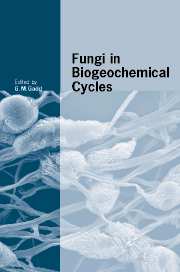Book contents
- Frontmatter
- Contents
- List of Contributors
- Preface
- 1 Geomicrobiology: relative roles of bacteria and fungi as geomicrobial agents
- 2 Integrated nutrient cycles in boreal forest ecosystems – the role of mycorrhizal fungi
- 3 Fungal roles in transport processes in soils
- 4 Water dynamics of mycorrhizas in arid soils
- 5 Integrating ectomycorrhizal fungi into quantitative frameworks of forest carbon and nitrogen cycling
- 6 Role of arbuscular mycorrhizal fungi in carbon and nutrient cycling in grassland
- 7 The role of wood decay fungi in the carbon and nitrogen dynamics of the forest floor
- 8 Relative roles of bacteria and fungi in polycyclic aromatic hydrocarbon biodegradation and bioremediation of contaminated soils
- 9 Biodegradation and biodeterioration of man-made polymeric materials
- 10 Fungal dissolution and transformation of minerals: significance for nutrient and metal mobility
- 11 Fungal activities in subaerial rock-inhabiting microbial communities
- 12 The oxalate–carbonate pathway in soil carbon storage: the role of fungi and oxalotrophic bacteria
- 13 Mineral tunnelling by fungi
- 14 Mineral dissolution by ectomycorrhizal fungi
- 15 Lichen biogeochemistry
- 16 Fungi in subterranean environments
- 17 The role of fungi in carbon and nitrogen cycles in freshwater ecosystems
- 18 Biogeochemical roles of fungi in marine and estuarine habitats
- Index
- References
18 - Biogeochemical roles of fungi in marine and estuarine habitats
Published online by Cambridge University Press: 10 December 2009
- Frontmatter
- Contents
- List of Contributors
- Preface
- 1 Geomicrobiology: relative roles of bacteria and fungi as geomicrobial agents
- 2 Integrated nutrient cycles in boreal forest ecosystems – the role of mycorrhizal fungi
- 3 Fungal roles in transport processes in soils
- 4 Water dynamics of mycorrhizas in arid soils
- 5 Integrating ectomycorrhizal fungi into quantitative frameworks of forest carbon and nitrogen cycling
- 6 Role of arbuscular mycorrhizal fungi in carbon and nutrient cycling in grassland
- 7 The role of wood decay fungi in the carbon and nitrogen dynamics of the forest floor
- 8 Relative roles of bacteria and fungi in polycyclic aromatic hydrocarbon biodegradation and bioremediation of contaminated soils
- 9 Biodegradation and biodeterioration of man-made polymeric materials
- 10 Fungal dissolution and transformation of minerals: significance for nutrient and metal mobility
- 11 Fungal activities in subaerial rock-inhabiting microbial communities
- 12 The oxalate–carbonate pathway in soil carbon storage: the role of fungi and oxalotrophic bacteria
- 13 Mineral tunnelling by fungi
- 14 Mineral dissolution by ectomycorrhizal fungi
- 15 Lichen biogeochemistry
- 16 Fungi in subterranean environments
- 17 The role of fungi in carbon and nitrogen cycles in freshwater ecosystems
- 18 Biogeochemical roles of fungi in marine and estuarine habitats
- Index
- References
Summary
Introduction
Oceans cover around 70% of the global surface area, yet remain one of the least explored regions for fungal diversity; consequently knowledge of the fungal contribution to ecosystem processes in these marine environments is extremely limited. For the purposes of this review, marine habitats are defined as those influenced in some way by seawater, generally from existing saline water bodies. In some cases, saline habitats have resulted from salt accumulation in soils originating from ancient seas. Broadly, marine ecosystems divide between those influenced in some way by terrestrial environments, generally situated close to coastal regions, and those associated with the open ocean. Broad boundaries within marine environments are detailed in Table 18.1, where coastal and open ocean, and the effect of depth within open oceans, is differentiated. Marine environments tend also to be strongly linked, representing movement between different regions of seas and oceans, as summarized in Fig. 18.1. In coastal regions, numerous types of marine environment develop, including saline wetlands and lagoons on low-energy coasts, estuarine systems where there is freshwater influx, and a range of beach and splash communities on high-energy coasts. Such ecosystems are reviewed in more detail by Packham and Willis (1997). Adjacent to coastal regions, and where continental shelves are shallow, coastal sea communities form, including coral reefs, which are found in both tropical and cold seas. A number of inland saline environments also exist, such as salt pans and salt deserts.
- Type
- Chapter
- Information
- Fungi in Biogeochemical Cycles , pp. 436 - 461Publisher: Cambridge University PressPrint publication year: 2006
References
- 7
- Cited by

